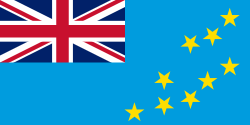Public holidays in Tuvalu
Also, the regions observe the following regional holidays:[2]
| Date | Atoll/Island | Name | Remarks |
|---|---|---|---|
| 8 January | Nanumea | Te Po o Tefolaha | The day Nanumea embraced Christianity brought by the London Missionary Society through Samoan pastors.[3] |
| 11 February | Nukufetau | Te Aso o Tutasi | Honors the Tutasi school. |
| 16 February | Nui | Bogin te Ieka (Day of the Flood) | Commemorates the Tsunami that struck the island on that day in 1882.[4][5] |
| 15 April | Nanumaga | Aho o te Fakavae | |
| 23 April | Funafuti | Funafuti Bomb Day | Commemorates the day during the Pacific War (World War II) when 680 people took refuge in the concrete walled, pandanus-thatched church from a Japanese bombing raid. Corporal B. F. Ladd, an American soldier, persuaded them to get into dugouts, as a bomb struck the building shortly after.[6] |
| moveable in May | Nukulaelae | Aso o te Tala Lei | Island-specific Gospel Day. |
| 17 September | Niutao | Te Aso o te Setema | |
| 21 October | Funafuti | Cyclone Day | Commemorates Cyclone Bebe's destruction of Funafuti in 1972.[7][8] |
| 25 November | Vaitupu | Te Aso Fiafia (Happy Day) | Commemorates 25 November 1887 which was the date on which the final instalment of a debt of $13,000 was repaid to H. M. Ruge and Company.[9] |
The following are public holidays in Tuvalu.[1]
| Date | English name | Tuvaluan name |
|---|---|---|
| 1 January | New Year's Day | Tausaga Fou |
| Second Monday in March | Commonwealth Day | |
| moveable in spring | Good Friday | |
| moveable in spring | Holy Saturday | |
| moveable in spring | Easter | |
| moveable in spring | Easter Monday | |
| Second Monday in May | Gospel Day | Te Aso o te Tala Lei |
| Second Saturday in June (can vary if appointed differently) | Queen's Official Birthday | |
| First Monday in August | National Children's Day | Aso Tamaliki |
| 1 October (public holiday continues 2 October) | Tuvalu Day | |
| Second Monday in November | Heir to the Throne's Birthday | |
| 25 December | Christmas Day | Kilisimasi |
| 26 December | Boxing Day |
References
- "Public Holidays Act". Pacific Islands Legal Information Institute. 2008. Retrieved 12 April 2018.
- Lalua, Silafaga (3 January 2007). "Island special public holidays". tuvalu-news.tv. Retrieved 23 April 2014.
- Te Po o Tefolaha
- Sotaga Pape, Hugh Laracy (ed.) (1983). "Chapter 10 – Nui". Tuvalu: A History. Institute of Pacific Studies, University of the South Pacific and Government of Tuvalu. pp. 74–75.CS1 maint: extra text: authors list (link)
- "Nowhere to run. Tuvaluans consider their future after Tropical Cyclone Pam". Report from International Federation of Red Cross And Red Crescent Societies. 17 April 2015. Retrieved 17 April 2015.
- Melei Telavi, Tuvalu A History (1983) Ch. 18 War, U.S.P./Tuvalu, p. 140
- Resture, Jane (17 May 2004). "Tuvalu and the hurricanes". Retrieved 23 April 2014.
- "Funafuti natives celebrate Hurricane Bebe". tuvalu-news.tv. 23 October 2006. Retrieved 23 April 2014.
- Kalaaki Laupepa, Hugh Laracy (ed.) (1983). "Chapter 11 – Vaitupu". Tuvalu: A History. Institute of Pacific Studies, University of the South Pacific and Government of Tuvalu. p. 82.CS1 maint: extra text: authors list (link)
This article is issued from Wikipedia. The text is licensed under Creative Commons - Attribution - Sharealike. Additional terms may apply for the media files.
